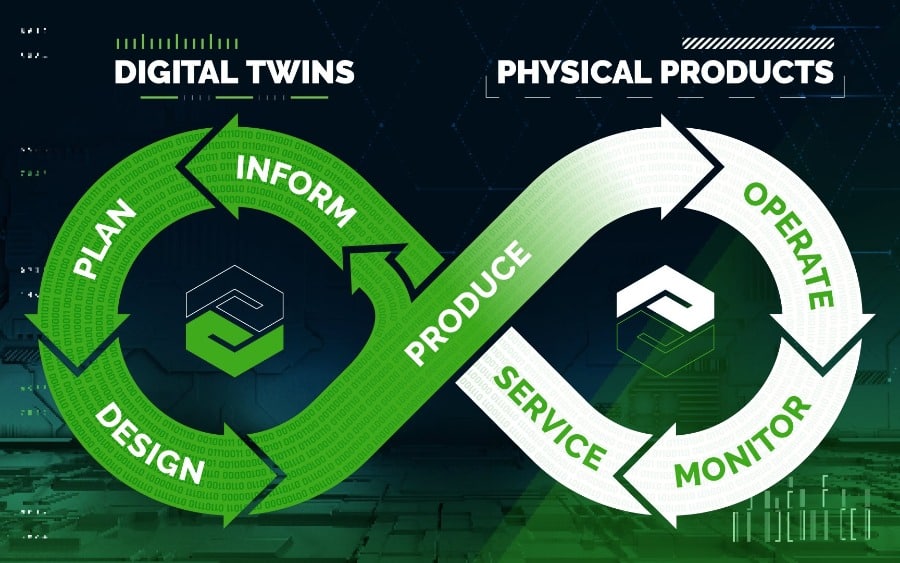“Digital transformation” has been a hot buzzword over the course of 2018 and that trend doesn’t appear to be slowing down in 2019. Whether you have your strategies all planned out for the year or are just getting started – here are the big digital transformation manufacturing trends we anticipate to see over the course of the year.
Digital transformation in manufacturing involves multiple integrated factors and technology that each reinforce and enhance the impact of other trends.

We Are in the Midst of the 4th Industrial Revolution
This year we will continue our journey in the fourth industrial revolution. Also known as Industry 4.0, this current revolution refers to how maturing technologies are drastically changing manufacturing operations. Looking back at history:
- The first industrial revolution was pioneered by the steam engine.
- The second industrial revolution was supported by electricity enabling manufacturing to mass produce with faster machinery and assembly lines.
- The third industrial revolution occurred as the use of computerized systems like ERPs because commonplace, significantly improving manufacturing management.
The current industrial revolution is supported by numerous technologies coming together to change how the entire manufacturing process occurs. These technologies include big data analytics, additive manufacturing, robotics, virtual reality (VR), artificial intelligence (AI), nanotechnology and more.
In this post, we will cover the most impactful industry 4.0 technologies in more detail.
The Future Will Be 3D Printed
Also known as additive manufacturing, the evolution of this technology is changing many aspects of production and is starting to be used in a wider variety of applications.
Reduce Prototyping Costs
Additive manufacturing removes the need to create multiple iterations of mechanical prototypes. Instead, manufacturers can create and recreate custom components easily as the design changes. This significantly reduces the costs associated with creating one-off parts and components for each design.
A Wide Variety of Applications
3D printing is no longer relegated to just plastic materials and hobbyists. New materials coupled with faster machines that can produce at mass quantity rates is increasing the use of 3D printing everywhere. It is even making major breakthroughs in other areas like biotech, where teams are learning to grow organs for transplant, and the food industry, where it is being used to create new foods.
With faster machines and a wide variety of materials, 3D printed products are everywhere.

Revolutionizing Product Design
The largest impact 3D printing is having on the manufacturing industry is how it changes the entire product design process. Engineers used to be constrained by a variety of factors from prototyping costs, to material types, to certain geometries. 3D printing means engineers are no longer held back by the ability of machines to remove materials from blocks of materials and, instead, designed products with unique geometries layer by layer. This enables the creation of strong and lightweight parts with better performance at lower costs. The latest 3D CAD solutions, like PTC Creo, incorporate additive manufacturing design into their platforms to help engineers bridge the gap between traditional methods and new possibilities.
The Internet of Things (IoT) and Industrial Internet of Things (IIoT) Will Connect Everything
Small sensors are placed on machines to connect them directly to operations to product updates and alerts, all supported by the internet of things (IoT). IoT is particularly useful for manufacturing in dangerous conditions where it is safer for teams to monitor operations remotely.
Sensors make it possible for workers to monitor dangerous conditions remotely.
IoT can also be used to automatically order and deliver consumables at various sites. Instead of a person having to place an order, a sensor can detect when a material is low and automatically create the order to have paper, toner, reagents, chemical, or safety equipment delivered.
Smart Connected Operations Will Optimize Productivity
Smart and connected operations supported by IoT and IIoT will improve operational efficiency. Teams can monitor operations remotely and systems can send alerts as conditions approach present thresholds. For example, if sensors notice high variation on a typical operation, they can notify management to investigate the issue or notify them of what exactly needs to be fixed. By getting these alerts in a timely manner, there is less scrap and rework, which helps to reduce costs.
Smart and connected operations help improve workflows and save money by making it easy to plan for maintenance and prevent unscheduled downtime.
Connected operations can also prevent unnecessary downtime by alerting teams that a machine needs service. With this information, maintenance can be scheduled at an optimal time instead of having to halt operations and deal with last-minute delays.

Augmented Reality (AR) Will Change How We See the World
Augmented reality (AR) is changing how we see the world – literally. AR is being implemented across manufacturing operations to help reduce costs and improve quality. It is being used in training with smart screens to show product line workers exactly how to perform an operation. This helps reduce the probability of improper assembly and other safety concerns. Using screens and AR together is a much faster and cost-efficient way to complete training. Assembly and operations instructions no longer have to be created by hand. Plus, many 3D CAD systems can automatically generate these instructions during the design phase without any additional human input.
AR helps improve production line training while improving costs.
Besides the production line, AR can also be used throughout the design process to improve collaboration. Having the ability to see how a product will look and operate in the real world makes it significantly easier to make important design decisions and prevent costly reworks during the prototyping process.
Stay Ahead of the Trends
The digital transformation in manufacturing is not slowing down. These 2019 trends are just the beginning of the changes to come. Who knows what kinds of technologies will continue to be developed and deployed using these methods?
To learn more about the tools and technologies that can help you stay up to date with the latest digital transformation trends contact us.

